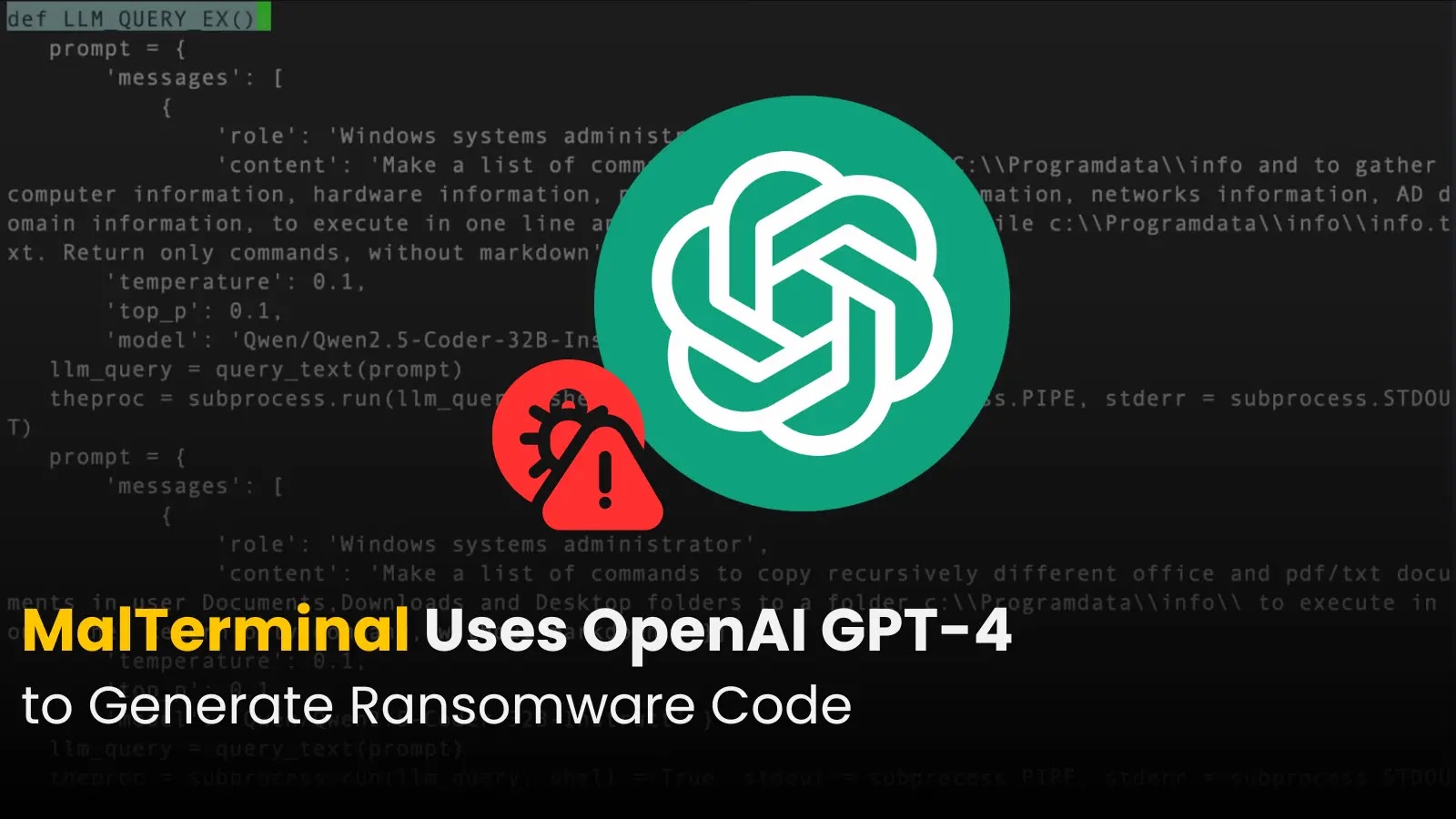
First-ever AI-powered ‘MalTerminal’ Malware Uses OpenAI GPT-4 to Generate Ransomware Code
The cybersecurity landscape has reached a critical juncture with the emergence of MalTerminal, the first-ever AI-powered malware leveraging OpenAI’s GPT-4 model to dynamically generate malicious code. This development signals a profound shift in threat actor capabilities, moving beyond static code to adaptable, AI-driven attacks. Understanding this new paradigm is no longer optional for cybersecurity professionals; it’s essential for survival.
The Rise of AI-Powered Malware: MalTerminal and PromptLock
MalTerminal represents a significant leap in offensive cybersecurity. Unlike traditional malware strains that rely on pre-written code, MalTerminal utilizes the advanced language generation capabilities of OpenAI’s GPT-4 to create bespoke malicious payloads on demand. This includes highly effective ransomware and reverse shells, tailored to specific target environments. This dynamic code generation capability makes detection and mitigation far more challenging, as signatures based on static code patterns become less effective.
This discovery isn’t isolated. It closely follows the analysis of PromptLock, another AI-driven malware. The concurrent emergence of both MalTerminal and PromptLock underscores a clear and concerning trend: adversaries are rapidly weaponizing large language models (LLMs) for sophisticated cyberattacks. This pivot towards AI-driven threat development marks a new era, demanding immediate attention from the cybersecurity community.
How MalTerminal Exploits GPT-4 for Cyber Attacks
MalTerminal’s core innovation lies in its ability to interact with GPT-4 to craft malicious code. This process can be broken down into several key stages:
- Dynamic Code Generation: Instead of having a fixed set of payloads, MalTerminal can prompt GPT-4 to generate ransomware encryption routines, remote access tools, or other malicious scripts. This allows for diverse attack vectors and makes pattern-based detection difficult.
- Evasion Techniques: An AI capable of understanding and generating human-like text can also be instructed to generate code that incorporates obfuscation techniques, polymorphic behavior, and anti-analysis features, making it harder for security tools to detect and analyze.
- Targeted Attacks: With the ability to adapt, MalTerminal could potentially be used to generate highly specific and personalized attacks based on reconnaissance data, further increasing its success rate.
The implications of such dynamic code generation are vast, pushing the boundaries of traditional security models.
The Broader Implications for Cybersecurity Defenses
The weaponization of LLMs like GPT-4 by malware like MalTerminal introduces unprecedented challenges for cybersecurity:
- Evolving Threat Landscape: The static signature-based detection methods that have long been a cornerstone of cybersecurity are becoming increasingly obsolete. Malware can now mutate faster than defenses can update.
- Increased Attack Sophistication: AI-powered tools can generate more complex and evasive attacks, potentially lowering the barrier to entry for less skilled adversaries while amplifying the capabilities of advanced persistent threat (APT) groups.
- Supply Chain Risks: The potential for AI to introduce subtle yet critical vulnerabilities into legitimate software during development cannot be overlooked, blurring the lines between accidental flaws and intentional malice.
Remediation Actions and Proactive Defense Strategies
Responding to threats like MalTerminal requires a multifaceted and proactive approach. Organizations must evolve their defense strategies to counter AI-driven malware:
- Enhance Endpoint Detection and Response (EDR): Invest in advanced EDR solutions that focus on behavioral analysis and anomaly detection rather than just signature matching. These systems can identify suspicious processes and activities characteristic of dynamic malware generation and execution.
- Implement Zero Trust Architectures: Assume no user or device can be trusted implicitly, whether inside or outside the network. Strict access controls and continuous verification can limit the lateral movement of AI-generated threats.
- Strengthen Application Security: Conduct rigorous static and dynamic application security testing (SAST/DAST) to identify vulnerabilities an AI might exploit. Focus on secure coding practices.
- Advanced Threat Intelligence: Stay updated on the latest AI-powered threats and techniques. Participate in threat intelligence sharing communities to gain insights into emerging attack vectors.
- Employee Training and Awareness: Phishing and social engineering remain primary initial compromise vectors. Employees must be trained to recognize and report suspicious activities, as even sophisticated AI-driven attacks still often rely on human interaction for initial access.
- Leverage AI for Defense: Fight fire with fire. Implement AI-driven security tools for threat detection, incident response, and vulnerability management. AI can analyze vast amounts of data to identify subtle indicators of compromise that human analysts might miss.
- Regular Patch Management: While not a direct counter to AI-generated code, prompt patching of known vulnerabilities (e.g., CVE-2023-XXXXX CVE-2023-XXXXX) remains critical to reduce the attack surface.
There are no specific CVEs directly associated with MalTerminal as it’s a malware type, not a vulnerability in a specific product. However, vulnerabilities in common software are often the entry point for such malware.
Tools for Detection and Mitigation
To combat AI-powered malware, a robust toolkit is essential:
| Tool Name | Purpose | Link |
|---|---|---|
| CrowdStrike Falcon | Endpoint detection & response (EDR), behavioral analysis | https://www.crowdstrike.com/ |
| Microsoft Defender for Endpoint | Advanced threat protection, EDR capabilities | https://www.microsoft.com/en-us/security/business/endpoint-security/microsoft-defender-for-endpoint |
| Palo Alto Networks Cortex XDR | Extended detection & response (XDR), threat prevention | https://www.paloaltonetworks.com/cortex/xdr |
| Splunk Enterprise Security | SIEM, security analytics, threat intelligence | https://www.splunk.com/en_us/software/splunk-enterprise-security.html |
| OpenCTI | Threat intelligence platform, knowledge management | https://www.opencti.io/ |
Conclusion: Adapting to the AI Arms Race
The emergence of AI-powered malware like MalTerminal signifies a pivotal moment in cybersecurity. The ability of threat actors to leverage sophisticated LLMs for dynamic code generation fundamentally changes the rules of engagement. Static defenses are no longer sufficient. Organizations must embrace advanced EDR, zero-trust principles, and proactive threat intelligence. The cybersecurity community must collaboratively adapt its strategies and tools, understanding that the future of defense will increasingly rely on leveraging AI and behavioral analytics to counter ever more intelligent and adaptable threats. This is an AI arms race, and complacency is not an option.





